Ssamjang is a Korean BBQ essential—a bold, savory dipping sauce that brings grilled meats and lettuce wraps to life. Rich and slightly spicy, this flavorful condiment blends doenjang (fermented soybean paste) with gochujang (red chili paste), creating a deep, umami-packed taste that perfectly complements smoky barbecue dishes.
In Korean BBQ, ssamjang shines as a versatile condiment. It's traditionally slathered onto lettuce leaves before adding grilled beef, pork, or chicken, adding a punch of savory depth to every bite. Whether you're a longtime fan of Korean cuisine or just starting to explore it, ssamjang is a simple yet powerful way to elevate your BBQ experience.
For those looking to recreate the magic of Korean barbecue at home, making ssamjang is both easy and rewarding. By mixing a few simple ingredients, you can enjoy this iconic sauce with your favorite dishes. Ssamjang is not just a dipping sauce; it’s a gateway to exploring the rich flavors of Korean cuisine.
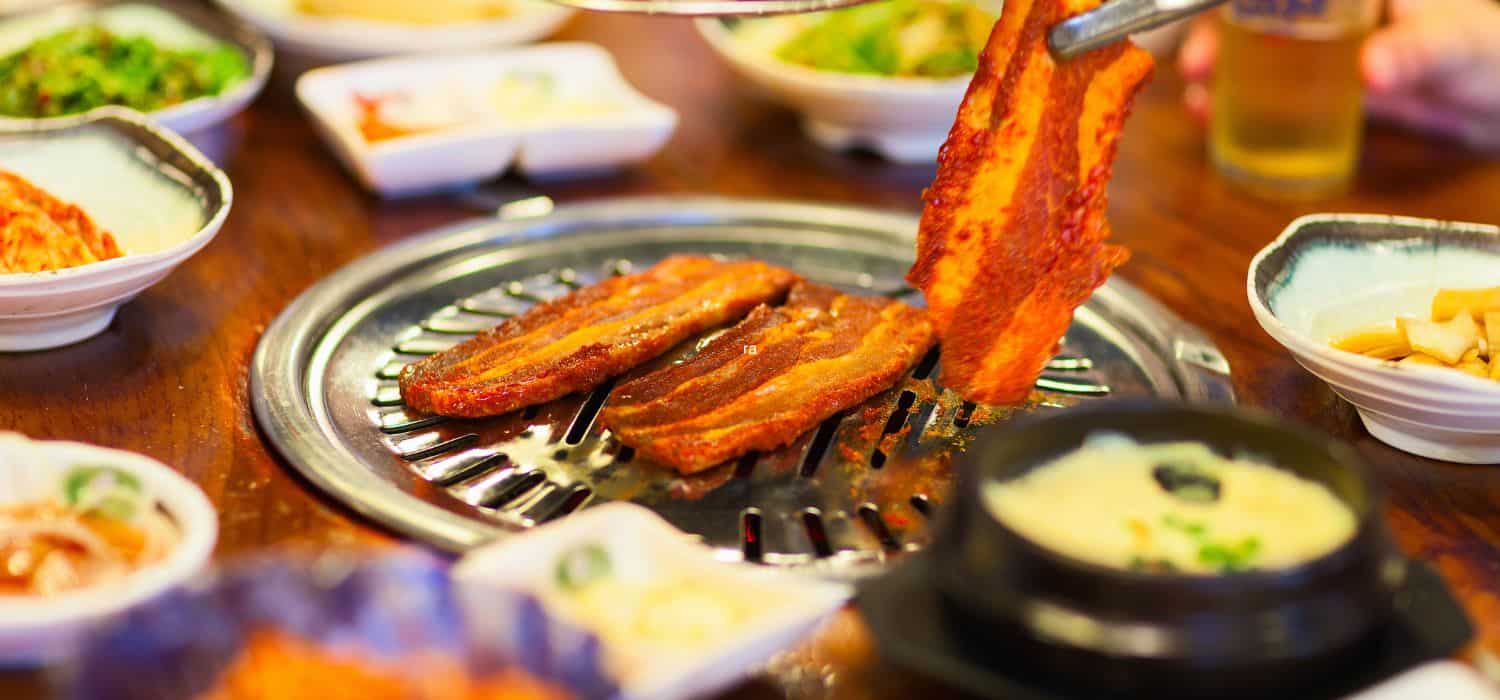
Jump to:
⌛ The Origin and Cultural Significance
Historical Roots
Ssamjang’s roots are deeply connected to traditional Korean cuisine. The name literally means “wrap sauce,” a nod to its classic use in lettuce wraps. Made primarily from doenjang (fermented soybean paste) and gochujang (red chili paste), this condiment brings together two foundational ingredients in Korean cooking to create a bold, savory flavor.
Historically, the core ingredients of ssamjang—doenjang and gochujang—have been used in a wide range of Korean dishes, highlighting their cultural significance. Blending these pastes with garlic, sesame oil, and chopped onions has long been a favorite way to enhance the flavor of wraps.
This time-honored method has been passed down for generations, cementing ssamjang as a flavorful cornerstone of Korean dining traditions.
Additionally, as society evolved, so did the recipes. Variations with nuts, seeds, and even sugar emerged, adapting to diverse tastes and making the sauce appealing to both young and old.
Ssamjang in Modern Korean Cuisine
Today, ssamjang is an essential part of modern Korean cuisine. It's commonly served with Korean BBQ, where diners create wraps using fresh lettuce leaves. The bold flavors add depth to grilled meats and vegetables, enhancing the overall experience.
This sauce is also available in pre-made versions at Korean grocery stores, making it easy for anyone to enjoy traditional flavors at home. The accessibility of ssamjang has helped it gain popularity, even outside Korea.
In cultural settings, ssamjang represents more than just a condiment. It brings people together around the table, promoting a sense of community and sharing. Whether it's a family dinner or a festive holiday, ssamjang is often present, embodying the spirit of Korean hospitality and love for good food.
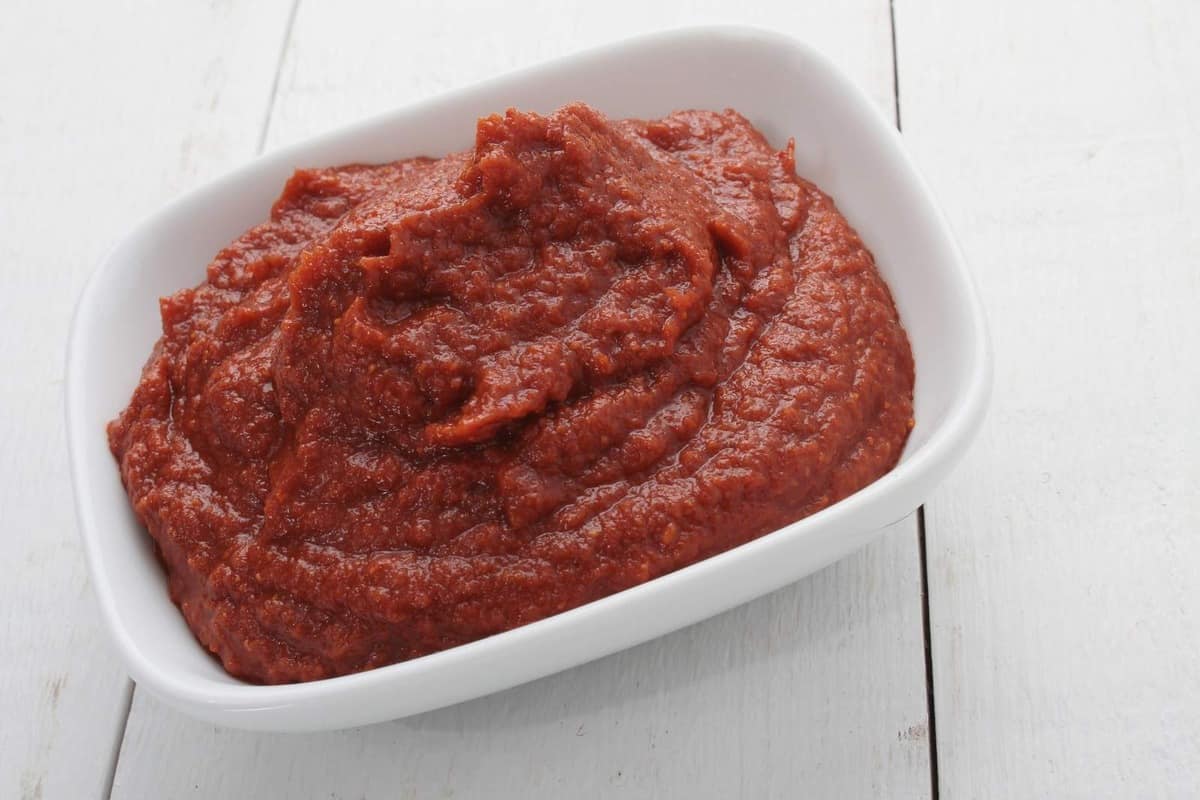
🧄 Essential Ingredients
The Base: Doenjang and Gochujang
The foundation of ssamjang is 2 essential Korean condiments: doenjang and gochujang. Doenjang is a fermented soybean paste that brings a rich, umami depth to the sauce. It’s known for its deep, complex flavors that have a slightly salty edge.
Gochujang, on the other hand, is a spicy red chili paste made from fermented soybeans and chili powder. It’s sweet and spicy, adding a kick to the ssamjang that makes it stand out. The combination of these two bases gives ssamjang its trademark balance of flavors, making sure it’s both savory and spicy.
Flavor Enhancers: Garlic and Onion
To boost the taste, garlic and onion are added to ssamjang. Garlic provides a pungent, aromatic quality that enhances the overall flavor profile. When minced, it blends seamlessly into the paste, giving every bite a little bit of zing.
Chopped onion adds sweetness and a slight crunch to the mix. It's often finely diced, so it melds well with the other ingredients, contributing a subtle yet noticeable sweetness that rounds out the savory and spicy elements. Some recipes might also include green onions for an extra layer of freshness.
Adding Aroma: Sesame Oil and Seeds
Sesame oil is crucial for adding a nutty aroma to ssamjang. Just a few drops can transform the sauce, making it more fragrant and rich. It also helps to bind the other ingredients together, ensuring a smooth consistency.
Toasted sesame seeds are often sprinkled in as well. They give a delightful texture contrast and an additional layer of nutty flavor. You might also find crushed sesame seeds, which integrate even better with the paste, giving it a slightly grainy texture that many find appealing.
These ingredients together elevate the ssamjang, making it irresistible whether you’re dipping grilled meats or fresh veggies.
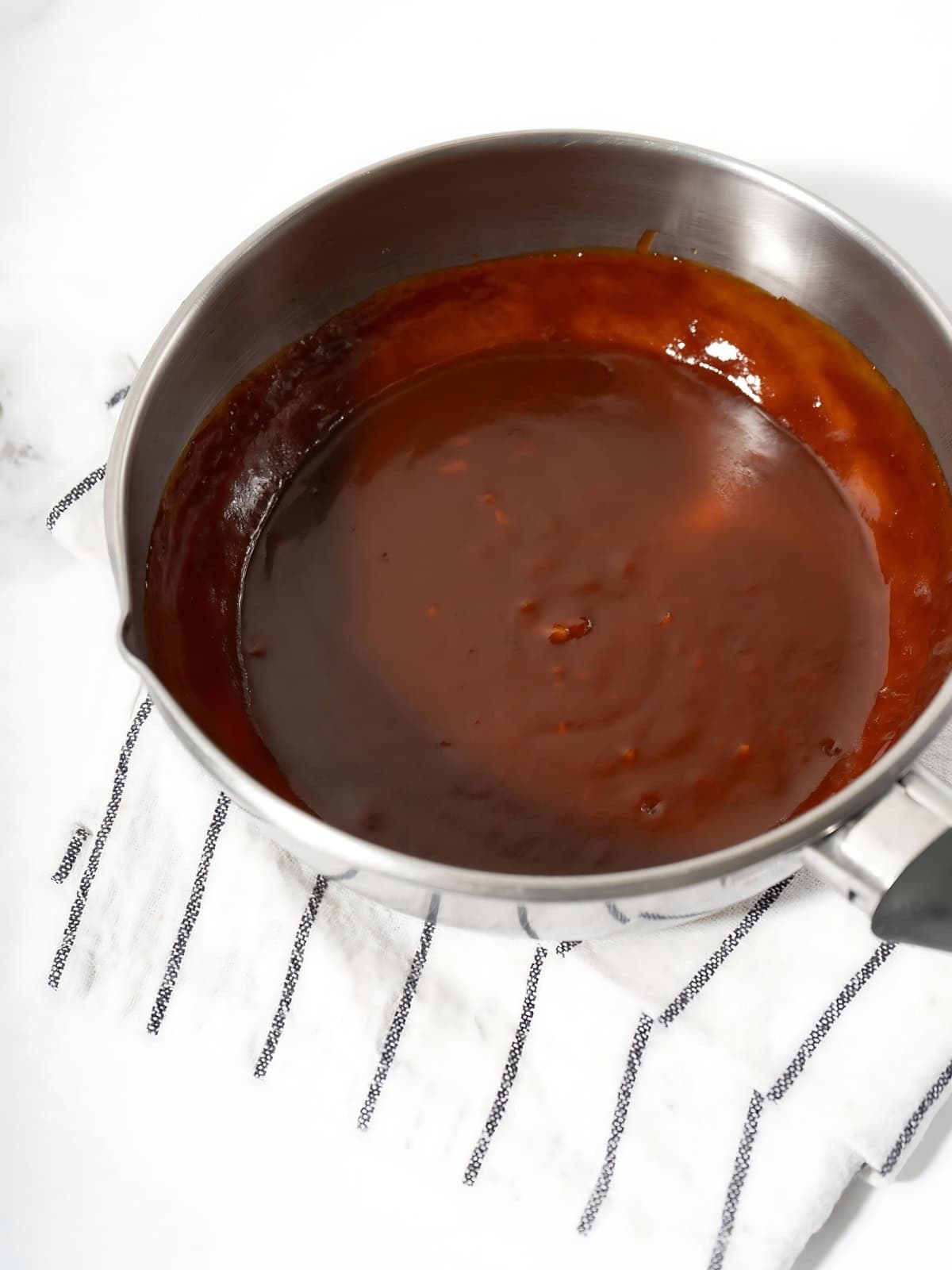
🥣 Ssamjang Preparation
In a bowl, mix 2 tablespoons of doenjang and 2 tablespoons of gochujang. Add one teaspoon of minced garlic and two teaspoons of sesame oil. To enhance the taste, a bit of honey or sugar can be used for sweetness. Stir everything together until you get a thick, well-blended paste.
This simple mixture offers a flavorful addition to any Korean BBQ meal. The umami from the doenjang and the heat from the gochujang make a perfect balance.
You can add variations like finely chopped onions, sesame seeds, rice syrup, or honey for extra sweetness. Ssamjang is a versatile and customizable sauce. It can easily be adapted to suit personal preferences and enhance various dishes.
😋 Tasting Ssamjang
Flavor Profile
Ssamjang has a bold and vibrant flavor. It's primarily savory, thanks to the fermented soybean paste, known as doenjang, which provides a rich umami taste. This paste is often compared to Japanese miso but with a more intense and earthy flavor.
This savoriness is complemented by the spiciness from Korean chili paste, or gochujang. The chili paste adds a mild to moderate heat that's not overpowering but provides a nice kick.
Texture and Consistency
Ssamjang has a thick and creamy texture, making it perfect for dipping. The combination of doenjang and gochujang gives it a dense consistency that holds up well when paired with meats and vegetables.
Sesame oil adds a smooth and luscious feel, making the sauce easy to spread or dip into. Small bits of minced garlic and chopped scallions provide a slight crunch, adding texture and a bit of freshness.
Sometimes, nuts or seeds like walnuts or sesame seeds are included. These add a nuttier flavor and a bit of extra bite. The result is a sauce that's both rich and satisfying, with a texture that enhances its multifaceted taste.
🍱 Pairing With Foods
Classic Combinations
When it comes to classic combinations, ssamjang is commonly paired with grilled meats like pork belly and beef. In Korean BBQ, the sauce is often served with lettuce wraps and vegetables. Grilled pork belly, known as samgyeopsal, and beef short ribs, or galbi, are popular choices.
The typical way to enjoy it is to take a piece of grilled meat, wrap it in a lettuce or perilla leaf, and add a dab of ssamjang. This combination creates a balanced bite with savory, spicy, and fresh flavors.
Another great pairing is with bulgogi, marinated beef that is grilled to perfection. Adding ssamjang enhances the sweet and savory notes of the meat. Vegetables like carrots, cucumbers, and bell peppers can also be dipped in ssamjang for a healthy and flavorful snack.
Innovative Pairings
Ssamjang isn’t just for traditional Korean BBQ; it can be paired with a variety of other foods, too. One innovative pairing is with seafood, especially grilled fish or shrimp. The sauce adds a spicy kick that complements the natural flavors of the seafood.
For vegetarians, ssamjang can be used as a dip for vegetable wraps or as a spread on sandwiches and burgers. It can also be added to kimchi, giving it an extra layer of flavor.
Some people even enjoy ssamjang with Western dishes. Try it as a vegetable dip, or add it to tacos and burritos for a unique twist. Its versatility makes it a great addition to many dishes, offering endless possibilities for those willing to get creative in the kitchen.
🩺 Nutritional Information
Caloric Content
The caloric content in ssamjang can vary based on its ingredients. Typically, a serving of ssamjang, about 2 tablespoons, contains roughly 50-70 calories.
This mainly comes from the fermented soybean paste (doenjang) and the Korean chili paste (gochujang). Other ingredients like sesame oil and honey also contribute to the caloric content.
For those watching their calorie intake, it's a good idea to use ssamjang sparingly. While it's delicious, its rich flavor means a little goes a long way.
Health Benefits
One key ingredient in ssamjang is doenjang, which is rich in protein and beneficial for gut health due to its fermentation process.
Gochujang, another primary ingredient, contains capsaicin, which is known for its metabolism-boosting properties. Sesame oil in ssamjang adds healthy fats, which are good for the heart.
The inclusion of garlic and onions provides additional nutrients like vitamin C and antioxidants. Regularly consuming ingredients like these can support overall well-being.
🥄 Serving and Storage
Proper Serving Techniques
Ssamjang is best enjoyed with Korean BBQ dishes. To serve it, place a small amount on a lettuce leaf along with grilled meat and vegetables. You can also dip cooked meat directly into the sauce for a burst of flavor.
When planning a meal, portion the ssamjang into individual dipping plates. This keeps the sauce hygienic and ensures everyone gets enough.
It's usually served at room temperature, but chilling it slightly can also enhance its taste when paired with warm foods.
Longevity and Preservation
To store ssamjang, transfer it to an airtight container. This helps maintain its flavor and prevents contamination. Keep the container in the fridge for optimal freshness. Stored properly, ssamjang can last up to 2 weeks.
If you need to store it for longer, consider keeping it in the back of the fridge where the temperature is coldest. Avoid leaving it in the pantry, as this can compromise its freshness.
Check for any changes in smell, color, or texture before using it again. Always use clean utensils when taking out the sauce to keep it fresh for as long as possible.
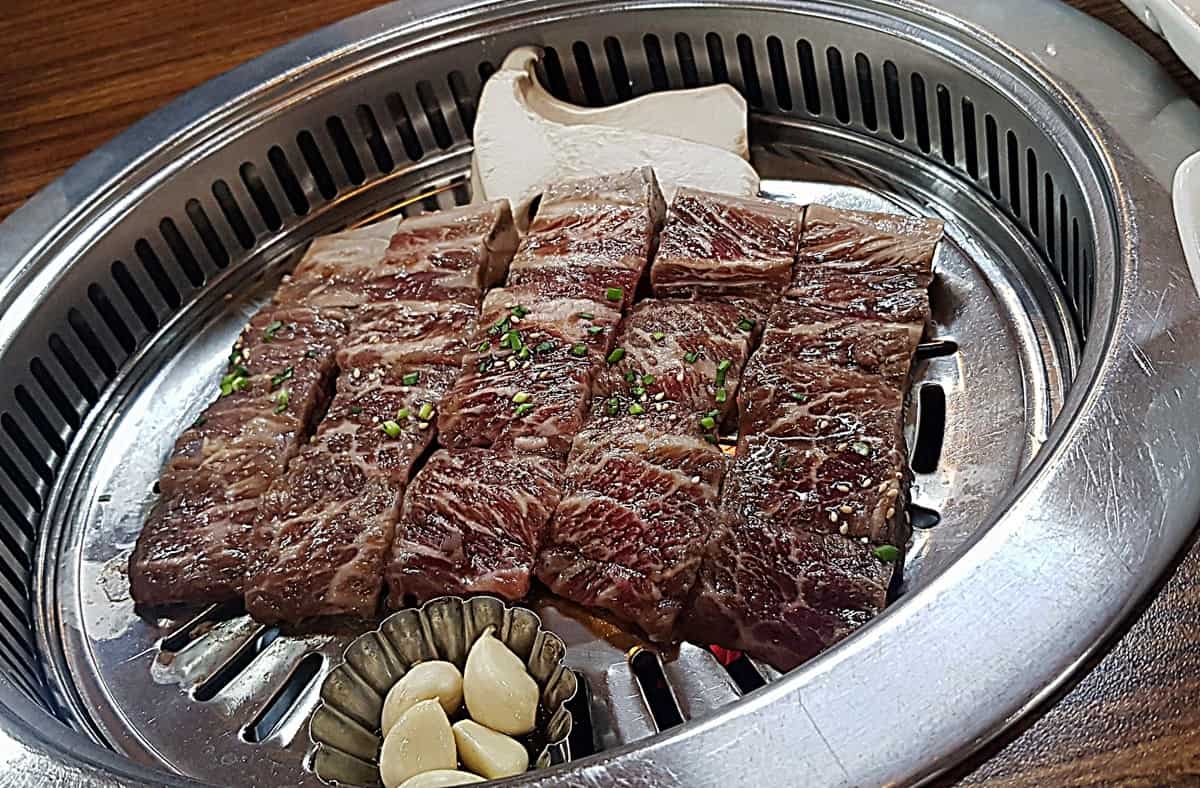
🥩 Exploring Korean BBQ
Getting the Right Ingredients
Getting high-quality ingredients is crucial to creating an authentic Korean BBQ experience. Samgyeopsal (pork belly) is a favorite for its tender and juicy texture. You can find this cut of meat at a Korean grocery store, which often sells it in thin slices perfect for grilling.
Another essential item is ssamjang, a rich and savory dipping sauce made with fermented soybean paste and chili paste. This Korean dipping sauce adds a kick to the meat and veggies.
Here's a shopping list to get you started:
- Pork belly
- Lettuce and perilla leaves
- Ssamjang and gochujang (chili paste)
- Garlic and sliced onions
- Sesame oil
- Kimchi
- Rice
Setting Up Your BBQ Experience
Setting up for Korean BBQ at home involves a few key steps. First, make sure you have a tabletop grill. Electric or gas grills are easy to use and control. Before grilling, marinate the meats using a mix of soy sauce, garlic, sesame oil, and sugar. This step ensures the meat is flavorful and tender.
Set the table with an assortment of side dishes, known as banchan. These can include kimchi, pickled radish, and seasoned spinach. Arrange the lettuce and perilla leaves, as they’re used to wrap grilled meat with rice and a dab of Korean BBQ dipping sauce.
During the meal, encourage guests to try different combinations of meat, vegetables, and Korean dipping sauces. The whole experience is interactive, making it a delightful way to enjoy a meal. A few beers or soju can also complement the meal well, adding to the festive atmosphere.
🤯 Creative Culinary Ideas
Ssamjang Burgers
Add a unique twist to your burgers by mixing ssamjang into the beef patties before grilling. The spicy and savory flavors complement the juicy meat, creating a delightful fusion dish. Spread a bit more ssamjang on the buns for an extra kick.
Ssamjang Tacos
Give your tacos a taste of Korea by using ssamjang instead of traditional salsa. Marinate your choice of protein, like chicken, beef, or pork belly with ssamjang, and serve in lettuce wraps or tortillas. Top with shredded lettuce, cheese, and a dollop of sour cream.
Ssamjang pizza
Use ssamjang as a base sauce for pizza. Spread it on the dough instead of tomato sauce, then add toppings like grilled vegetables, mushrooms, and nuts like thinly sliced walnuts. The combination of the spicy ssamjang and the toppings offers a bold, delicious flavor.
Ssamjang Glazed Salmon
For a flavorful dinner, glaze salmon with ssamjang mixed with a bit of maple syrup. Bake or grill the salmon until it’s cooked through, and serve with a side of steamed rice and grilled vegetables. The sweet and spicy glaze perfectly enhances the rich taste of the salmon.
Ssamjang Salad Dressing
Transform your salads with a ssamjang-based dressing. Mix ssamjang with a little soy sauce, vinegar, and sesame oil. Drizzle over a salad made with lettuce leaves, spinach, and sliced apples. Top with walnuts for added crunch and flavor.
Ssamjang Stir-Fry
Create a quick and tasty stir-fry by adding ssamjang to your favorite combination of mushrooms, bell peppers, carrots, and chicken. The ssamjang adds a depth of flavor, making the dish both savory and slightly spicy. Serve over steamed rice or wrapping sauce.
❓ Frequently Asked Questions
To make homemade ssamjang, mix soybean paste (doenjang), Korean chili paste (gochujang), sesame oil, minced garlic, and toasted sesame seeds. For added flavor, some recipes suggest including honey and thinly sliced onions. You can also add nuts like walnuts for a nuttier, creamier texture.
Beyond BBQ, ssamjang can be used as a dip for raw or steamed vegetables. It also makes an excellent spread for sandwiches and wraps or a flavorful addition to soups and stews. Some enjoy it mixed into rice or topping for tofu and other protein dishes.
Ssamjang sauce can be found in most Korean grocery stores. You can also find it online on various specialty food websites or larger e-commerce platforms. Look for brands that come in small tubs or jars to ensure freshness.
Ssamjang enhances flavors with its unique blend of savory, spicy, and slightly sweet tastes. The combination of doenjang and gochujang provides umami, making dishes more rounded and satisfying. The added sesame oil and garlic contribute depth and richness.

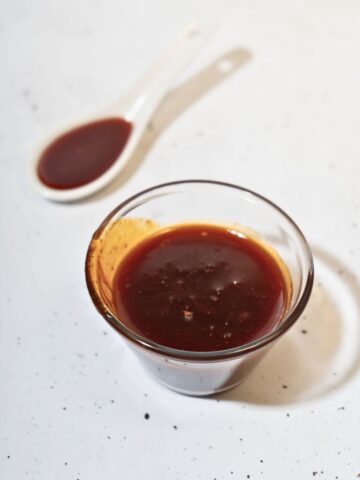
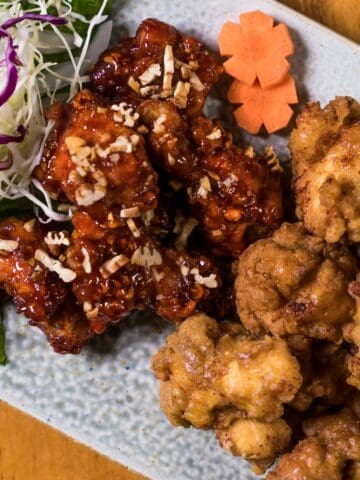

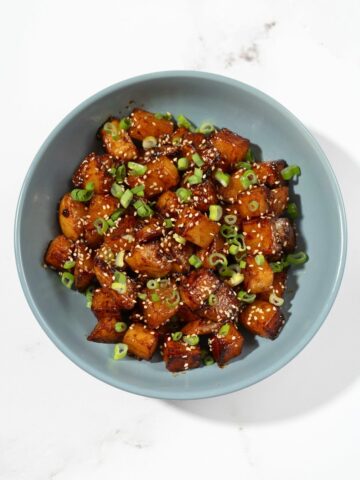
Comments
No Comments